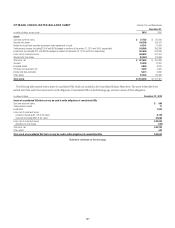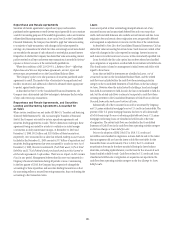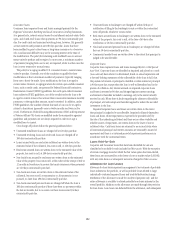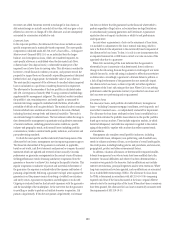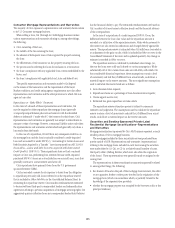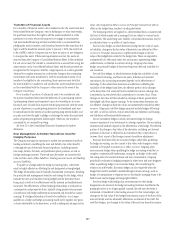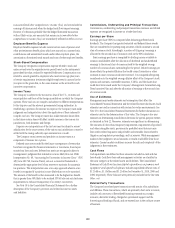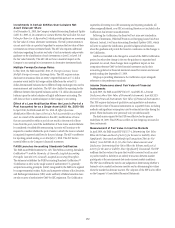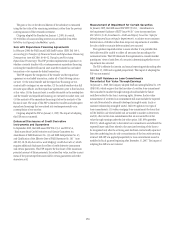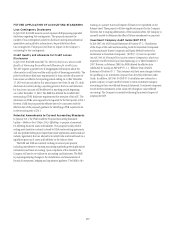Citibank 2010 Annual Report Download - page 169
Download and view the complete annual report
Please find page 169 of the 2010 Citibank annual report below. You can navigate through the pages in the report by either clicking on the pages listed below, or by using the keyword search tool below to find specific information within the annual report.167
Transfers of Financial Assets
For a transfer of financial assets to be considered a sale: the assets must have
been isolated from the Company, even in bankruptcy or other receivership;
the purchaser must have the right to sell the assets transferred or, if the
purchaser is an entity whose sole purpose is to engage in securitization
and asset-backed financing activities and that entity is constrained from
pledging the assets it receives, each beneficial interest holder must have the
right to sell the beneficial interests (prior to January 1 2010, the entity had
to be a QSPE); and the Company may not have an option or any obligation
to reacquire the assets. If these sale requirements are met, the assets are
removed from the Company’s Consolidated Balance Sheet. If the conditions
for sale are not met, the transfer is considered to be a secured borrowing, the
assets remain on the Consolidated Balance Sheet, and the sale proceeds are
recognized as the Company’s liability. A legal opinion on a sale is generally
obtained for complex transactions or where the Company has continuing
involvement with assets transferred or with the securitization entity. For a
transfer to be eligible for sale accounting, those opinions must state that
the asset transfer is considered a sale and that the assets transferred would
not be consolidated with the Company’s other assets in the event of the
Company’s insolvency.
For a transfer of a portion of a financial asset to be considered a sale,
the portion transferred must meet the definition of a participating interest.
A participating interest must represent a pro rata ownership in an entire
financial asset; all cash flows must be divided proportionally, with the same
priority of payment; no participating interest in the transferred asset may
be subordinated to the interest of another participating interest holder; and
no party may have the right to pledge or exchange the entire financial asset
unless all participating interest holders agree. Otherwise, the transfer is
accounted for as a secured borrowing.
See Note 22 to the Consolidated Financial Statements for further
discussion.
Risk Management Activities—Derivatives Used for
Hedging Purposes
The Company manages its exposures to market rate movements outside its
trading activities by modifying the asset and liability mix, either directly
or through the use of derivative financial products, including interest-
rate swaps, futures, forwards, and purchased-option positions, as well as
foreign-exchange contracts. These end-user derivatives are carried at fair
value in Other assets, Other liabilities, Trading account assets and Trading
account liabilities.
To qualify as a hedge under the hedge accounting rules, a derivative
must be highly effective in offsetting the risk designated as being hedged.
The hedge relationship must be formally documented at inception, detailing
the particular risk management objective and strategy for the hedge, which
includes the item and risk that is being hedged and the derivative that is
being used, as well as how effectiveness will be assessed and ineffectiveness
measured. The effectiveness of these hedging relationships is evaluated on
a retrospective and prospective basis, typically using quantitative measures
of correlation with hedge ineffectiveness measured and recorded in current
earnings. If a hedge relationship is found to be ineffective, it no longer
qualifies as a hedge and hedge accounting would not be applied. Any gains
or losses attributable to the derivatives, as well as subsequent changes in fair
value, are recognized in Other revenue or Principal transactions with no
offset on the hedged item, similar to trading derivatives.
The foregoing criteria are applied on a decentralized basis, consistent with
the level at which market risk is managed, but are subject to various limits
and controls. The underlying asset, liability or forecasted transaction may be
an individual item or a portfolio of similar items.
For fair value hedges, in which derivatives hedge the fair value of assets
or liabilities, changes in the fair value of derivatives are reflected in Other
revenue or Principal transactions, together with changes in the fair
value of the hedged item related to the hedged risk. These are expected to,
and generally do, offset each other. Any net amount, representing hedge
ineffectiveness, is reflected in current earnings. Citigroup’s fair value
hedges are primarily hedges of fixed-rate long-term debt and available-for-
sale securities.
For cash flow hedges, in which derivatives hedge the variability of cash
flows related to floating- and fixed-rate assets, liabilities or forecasted
transactions, the accounting treatment depends on the effectiveness of
the hedge. To the extent these derivatives are effective in offsetting the
variability of the hedged cash flows, the effective portion of the changes
in the derivatives’ fair values will not be included in current earnings, but
is reported in Accumulated other comprehensive income (loss). These
changes in fair value will be included in earnings of future periods when
the hedged cash flows impact earnings. To the extent these derivatives are
not effective, changes in their fair values are immediately included in Other
revenue. Citigroup’s cash flow hedges primarily include hedges of floating-
rate debt, as well as rollovers of short-term fixed-rate liabilities and floating-
rate liabilities and forecasted debt issuances.
For net investment hedges in which derivatives hedge the foreign
currency exposure of a net investment in a foreign operation, the accounting
treatment will similarly depend on the effectiveness of the hedge. The effective
portion of the change in fair value of the derivative, including any forward
premium or discount, is reflected in Accumulated other comprehensive
income (loss) as part of the foreign currency translation adjustment.
End-user derivatives that are economic hedges, rather than qualifying
for hedge accounting, are also carried at fair value, with changes in value
included in Principal transactions or Other revenue. Citigroup often
uses economic hedges when qualifying for hedge accounting would be too
complex or operationally burdensome; examples are hedges of the credit
risk component of commercial loans and loan commitments. Citigroup
periodically evaluates its hedging strategies in other areas and may designate
either a qualifying hedge or an economic hedge, after considering the
relative cost and benefits. Economic hedges are also employed when the
hedged item itself is marked to market through current earnings, such as
hedges of commitments to originate one-to-four-family mortgage loans to be
held-for-sale and mortgage servicing rights (MSRs).
For those hedge relationships that are terminated or when hedge
designations are removed, the hedge accounting treatment described in the
paragraphs above is no longer applied. Instead, the end-user derivative is
terminated or transferred to the trading account. For fair value hedges, any
changes in the fair value of the hedged item remain as part of the basis of the
asset or liability and are ultimately reflected as an element of the yield. For
cash flow hedges, any changes in fair value of the end-user derivative remain


